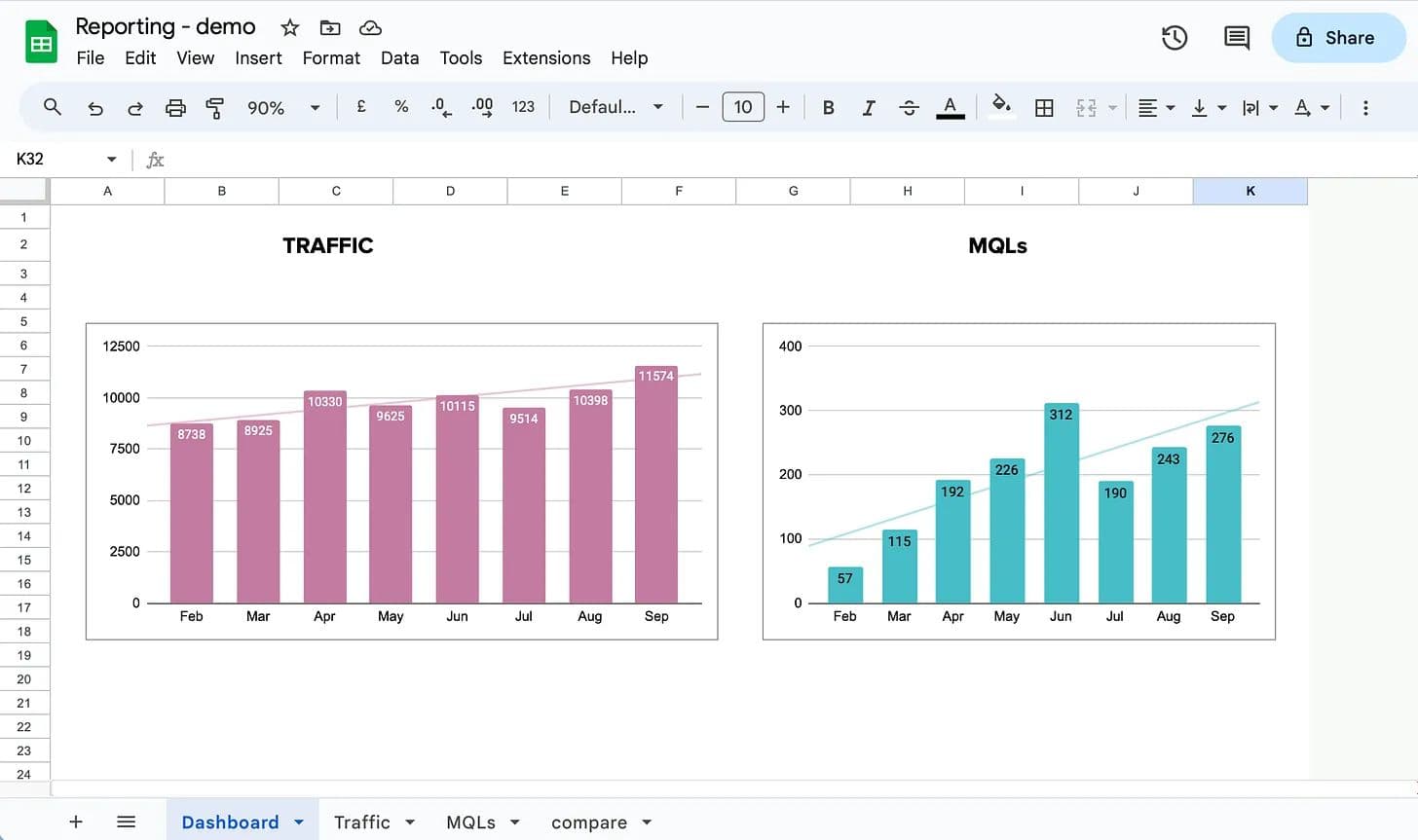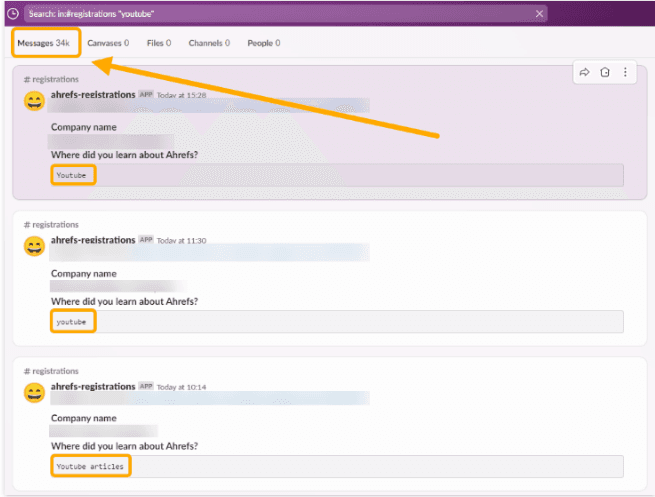Playing The Long-Game - How to measure the ROI of content
Diving into content measurement takes you everywhere from hardcore formulas, to deep-dive guides into Google Analytics, to impassioned pleas for all the measurement to just stop already so content people can create content that’s actually worth reading. And everything in between.

“Attribution is a waste of time.”
At least according to Jon Miller, co-founder of Marketo and OG of inbound marketing measurement, during a speech at Goldenhour 2024.
But wait, what? Aren’t we all aspiring to ever greater levels of content measurement?
Shouldn’t we be doubling down on proving the ROI on content and “doing more with less”?
Surely we aren’t seeing a return to the Bad Old Days of, “Look, we know this whole content thing is working, but we don’t really know why, and it’ll take about 6 months to do anything anyway, so just leave us alone, mm-kay?”
“Attribution is a waste of time.”
Well, no. Content marketing requires measurement. Now is most emphatically not the time to go to your CFO, cap in hand, to ask for budget based on whims and hunches.
It’s just that the right way to measure content isn’t always obvious. The metrics you choose to measure your results will dictate the content you create. And some metrics are more helpful than others.
Here, we’ll look at:
- Why content measurement is so hard in the first place—and why nobody agrees about how to measure it
- Different approaches to content measurement—and why none of us really think we’re doing it right
- How to choose your approach to content ROI based on your current biggest problem
Why is content measurement such a gnarly issue?
Diving into content measurement takes you everywhere from hardcore formulas, to deep-dive guides into Google Analytics, to impassioned pleas for all the measurement to just stop already so content people can create content that’s actually worth reading.
And everything in between.
Here’s why that might be:
Content isn’t just one thing
To quote Brooklin Nash, Co-founder of Beam Content,
“Stop trying to measure “content marketing” as a monolith. It’s not “content marketing” and then everything else—it’s content marketing, woven into everything else.”
“Stop trying to measure content marketing as a monolith”
Content performs at least three roles in marketing programs. They all need a different set of measurements.
Content is:
- Transactional—as in, “If you give me your email address, I will give you this e-book.”
- Relational—as in, “Because you like my excellent blog posts, you’ll think of me when you’re compiling your list of B2B software products to consider during your purchase process.”
- Supporting—as in, providing the sales team with a great ROI calculator so they can nail that pitch.
The transactional role of content might be the easiest to measure (number of MQLs, number of visitors to lead conversions, etc.)
But, depending on your content goals, it might also be the least important role that your content is doing for your brand. It makes sense that content marketers focusing on the relational goals of content are reluctant to use transactional metrics, but are not sure of what alternatives there are (in the absence of sophisticated sentiment tools or expensive brand awareness surveys.)
Brand awareness has a branding issue
Some content marketers want to pursue relational goals—or brand awareness goals, to call it by its real name. But brand awareness has…well, a branding issue. Liam Moroney, Co-founder of Storybook Marketing, comments:
“To quote a comment I saw today: ‘Brand awareness is the term marketers use for things they do that don’t drive measurable results.’
This is a true statement, but it doesn't mean the term is invalid because of this misuse. That's like arguing that the word ‘theory’ when it comes to the science of global warming is invalid because it's also being used to justify poor scientific opinions that conflict with evidence.”
“To quote a comment I saw today: Brand awareness is the term marketers use for things they do that don’t drive measurable results.”
However, if your business stakeholders believe that brand awareness is somehow “fluffy” and meaningless, then it’s likely to put you off using awareness metrics—even if they would be the most relevant metrics for what you’re currently trying to do with your content.
Nobody’s very good at attribution when it comes down to it
Getting squirmy about ROI isn’t a content marketing issue, it’s a marketing issue.

Image credit: Brooklin Nash
To quote Katie Norris, former Head of Content at Adyen turned content consultant:
“Content is usually part of a broader marketing function. So results often get absorbed into the overall results of a specific activity, such as an event, or digital campaign. And since attribution remains a big struggle for B2B marketing teams (both small and large) it’s incredibly hard to measure the impact of individual functions accurately.”
If we can’t prove attribution in general, then we certainly can’t prove it in content.
“Content is usually part of a broader marketing function. So results often get absorbed into the overall results of a specific activity, such as an event, or digital campaign.”
To go back to Jon Miller again, this time in an interview with Velocity:
“I just don’t think attribution data are all that accurate. We know that 7-10 people are usually involved across the buying cycle in every B2B sale. Each person has dozens of interactions with people, content, other customers, and friends before engaging. Many happen off your site and in closed or offline communities. You can’t capture those interactions.
“I just don’t think attribution data are all that accurate.”
And an obsession with attribution undermines the teamwork across the sales and marketing teams that’s required in the new GTM world. It’s much better to focus on whether the ‘go-to-market team’ wins together.”
Plus, even when you’ve got a marketing ops function that’s doing great things with attribution modeling, Ty Magnin, the CEO of Animalz, points out that they might not be prioritizing your content results:
“The marketing ops team is sitting very closely with demand gen, if not within that function. And demand gen then dominates their requests and their needs, and marketing ops never really gets to the brand stuff[...] Content marketing doesn't get the support.”
So, you have a situation where:
- Everyone is struggling with marketing attribution—and the content team might be struggling more than most (and with less support from Marketing Ops)
- What you might want to measure (your relationship with your target market) isn’t seen as a compelling metric
- The metrics that are easiest to measure and most accepted by business leadership aren’t always the best way to evaluate your content strategy
- Your primary role might be to drive results for other teams, and you don’t own those metrics
No wonder content people get a little angsty about measurement. So, what are some ways to do it anyway?
Apply for early access to Relato
- Secure your invite for early access
- Give feedback, have your say
- Receive news and updates
To measure content, figure out your biggest problem
The right metrics for your content program are going to vary depending on:
- Your budget
- Your content maturity
- Your current top priorities
In other words, what’s your biggest problem right now?
Problem #1: You need C-suite buy-in
OK, this is probably most of us. To quote Halah Flynn, a Senior Content Marketing Manager at Lattice:
“Content marketers have to prove their success to stakeholders that may have less context about the content process, as well as an expectation of immediate results. But many of the truest measures of success can take weeks or months to prove.”
“But many of the truest measures of success can take weeks or months to prove.”
And there’s a good chance said stakeholders might not be overly keen on the whole “it’s a long game” argument.
So, what to do?
Measure Return on content spend (ROCS)
One option is to take a leaf out of the demand gen playbook. Instead of return on ad spend (ROAS), start talking about return on content spend (ROCS). It even sounds kind of cool.
Plus, it works. When Lane Scott Jones, Director of Content at Zapier, showed her ROCS numbers to her CMO, his response was, “With these ROI numbers, tell me why I shouldn’t give you advertising’s entire budget right now?”
How to calculate ROCS:
On the one hand, tot up your content spend:
- Headcount
- Software
- Freelancers
- Tech support
- Data support
On the other hand, calculate your return, which could be:
- Influenced pipeline (which Zapier measured as “touched at least one piece of content right before upgrading to paid”, aka last touch)
- First-touch attribution (meaning, content gets full credit if the lead came to you via your content and then ends up purchasing—Magnin suggests this makes sense for PLG models)
ROCS is just
((Return from content − cost of content) / cost of content) * 100.
The problem, of course, is that this metric only paints a picture of what you’re doing as a standalone function, not what you’re doing as a service function (e.g. the results your content is getting for other teams.)
However, assuming you have a strong content marketing function, then using ROCS will most likely solve the problem of “convincing the CFO to give us money to keep doing what we’re doing”.
It’s a best-guess number, but a compelling one. Even with the very stringent limits they placed on what counted as influenced pipeline, Zapier still demonstrated an ROI of 450% with this metric.
Problem #2: You need to prove content ROI without a lot of fancy tools
You don’t necessarily need a lot of fancy technology to prove influenced pipeline. Although if you want to do a lot of attribution modeling and analytics they can certainly help.
But what if you don’t even want to get into attribution modeling? You just want to know “Is our content working?” Here are a few ways to do it (relatively) simply and cheaply:
1. Track your “most revenue-relevant metric” plus organic traffic
This phrasing comes from Fio Dossetto, the Content Lead at Float, who uses an “ugly but functional spreadsheet” to track content results. She recommends tracking your organic sessions (which she pulls straight from GA4) plus “the most revenue-relevant metric” you can manage to get at with your current tech stack—in this case, MQLs.

Image credit: Fio Dossetto.
If you’re going with this approach, then make sure you’re choosing the right metric, advises Jimmy Daly, CEO of Superpath:
“To measure impact, the company has to agree on the metric they feel most closely aligns with their objectives. For larger companies, that could be influenced pipeline, while for smaller companies, it could be as simple as MQLs, which could include emails collected via the newsletter and content upgrades.”
Jimmy also advocates for two or three metrics to show content impact.
“Once you start looking at 10+ metrics every month, the effect is watered down.”
“Once you start looking at 10+ metrics every month, the effect is watered down.”
2. Use the good old “How did you hear about us?”
Ryan Law, Director of Content Marketing at Ahrefs, explained in a recent blog that they use a refreshingly simple approach to proving ROI: sign-up attributions based on self-report.
They ask all Ahrefs signups a question with an open text field: Where did you hear about us? Their answer is piped into a dedicated Slack channel, #registrations.

Image credit: The ahrefs blog.
Obviously, this will mean their attribution metric is limited to:
- People who actually bother to fill out the form
- People who can spell the relevant term correctly
However, it can give you a broad-strokes idea about what’s working and how much it’s working. As Law points out:
“There are tons of ways to measure content marketing ROI, and none of them are perfect. But for practical purposes, they don’t need to be.
Metrics, like content marketing ROI, are most useful as directional indicators. Instead of obsessing over perfect calculations, it’s better to choose a simple methodology, stick to it consistently, and see how it changes over time.”
“There are tons of ways to measure content marketing ROI, and none of them are perfect. But for practical purposes, they don’t need to be.”
Plus, if nothing else, you might get a few laughs out of it.
Problem #3: You’re leaning into relational content, and you need to prove you’re getting somewhere
So far, we’ve looked at the transactional metrics of content. But content (like marketing in general) also needs to promote brand awareness to be effective. After all, nobody buys from brands they’ve never heard of, don’t trust, and don’t like.
As Margaret Kelsey, the CMO of Kodaris, points out on an episode of Don’t Say Content:
“Marketing is essentially two functions:
- Saturating channels that your target audience lives in with a message that resonates, frequently and consistently (this builds awareness and affinity over time).
- Identifying signals of readiness and getting people to do the thing you want them to do (get into the product, talk to sales, customers to renewal, etc)
The second you can measure clear ROI because it's a moment in time. But the first is much harder to do because by its very nature it's about the amount of times you show up.”
Apply to the waiting list
- Secure your invite for early access
- Give feedback, have your say
- Receive news and updates
It may be harder to measure the results of relational content, but it’s entirely possible. Here are a few options:
1. Measure volume and consistency of your content distribution
Kelsey advocates for measuring channel saturation in terms of content volume: “You measure it in terms of, ‘What are the channels that our target audience is in, and what frequency and consistency are we showing up in those channels?’”
Her point is that brand awareness is a relationship between the brand and the market that’s built over time. So you can’t measure content that aims at brand awareness in terms of conversions.
“We’re not trying to prompt action yet. We’re trying to make it cheaper and less cognitively dissonant for someone to take the action when action time comes, because they know who we are, because they trust us, because they like us[...] It doesn’t matter which influencer post or channel or moment it was that triggered the final action.”
“We’re trying to make it cheaper and less cognitively dissonant for someone to take the action when action time comes.”
2. Measure brand traffic as a proxy
Magnin likes the term “brand traffic” to capture more relational content metrics. This term encapsulates:
- Organic traffic
- Blog traffic
- Branded search (your company name in the search engine)
- Referral traffic from syndicated content
- Social traffic
Or you could simply track MoM branded search to gauge brand awareness.
3. Measure user experience as a proxy
Lattice prioritizes “organic search traffic, SERP rankings, and pipeline generation” as their top three measures. But they also measure their relationship with their readers with user experience metrics:
- Bounce rate
- Time on page
- Pages per session
Flynn explains, “We have a few articles that average two minutes for time on page, which tells us readers are really engaged in that topic, so we try to lean into the areas of interest and formats that are resonating with users.”
On a personal note—it’s not a coincidence that Lattice is one of my only clients who can tell me with any accuracy how “well” a single piece of content is doing.
Problem #4: You spend all day helping other teams with content, and need to prove you’re really helping
In many (most?) organizations, content isn’t just a standalone team. It’s also a service function that provides content to other teams. But, if you’re only measured on content-specific metrics, then a) you won’t get credit where it’s due and b) you might feel resentful for dedicating time to other teams—even if that’s where you’ll be most useful.
For instance, if you’re a sales-led organization, then your most powerful content might well be the sales collateral you’re preparing for your AEs. But it won’t make any difference to your organic traffic numbers.
To quote Nash, “Your SEO traffic doesn’t matter if it’s not converting into leads. Your leads don’t matter if they’re not qualified and converting into calls. Your calls don’t matter if they’re not converting into closed/won. Put another way: measuring content should be about measuring the lift that it gives your GTM counterparts.”
A few ways to get at that measurement:
1. Assign a percentage of other teams’ KPIs to content
Magnin suggests, “Product marketing is measured by adoption, so content marketing could get an assist there, right? In its finest form, it would mean content considering [the other teams’] goals their own—adoption metrics, pipeline generation, and so on.”
2. Track internal feedback
Flynn uses feedback from the sales team to measure internal effectiveness: “Any time we can help our sales team close a deal is a huge win for us. We solicit feedback about the usefulness and accessibility of our content in sales calls, and try to replicate the most successful attributes of that content throughout our library.”
You could also track:
- Mentions of content by prospects during discovery calls
- Internal surveys on content coverage and effectiveness by demand gen, sales, and customer support
- Number of times content used by sales team during sales process
- Views of content by prospects during deal progression
3. Set win-win metrics
Flynn also explains that the Lattice content team collaborated with demand gen and sales to figure out new ways of measuring content results that kept the other teams happy, while also lining up with their user-focused content strategy.
“For our most recent annual industry report, we made the entire report free and accessible on the page without needing to input an email. But we also knew we couldn’t fail our demand generation and sales teams. They depend on this report to drive demos and sales to close out the year, and we didn’t want our ambition for accessibility to make them fall short of their goals.”
The solution? Instead of gating the content, they set up CTAs “directing readers to more detailed resources, actionable templates, and product demos. These resources weren’t listed at the bottom as an afterthought, but rather naturally placed throughout the report as a complement to each section.
Our goal was to drive 70 downloads of our secondary resources, but we ended up achieving 472 downloads to date. Thinking more critically about a better, more accessible UX paid dividends for us and our readers.”
Content measurement will never be 100% accurate, but that doesn’t matter
I’ve yet to find anyone who claims they’ve found a perfect measurement for content ROI. But you don’t really need one. Instead, you need to choose measurements that:
- Reflect what you’re really trying to do with your content (not just what’s easiest to measure)
- Capture all of content’s three roles—generating conversions, building a relationship with the market, and supporting the rest of the team
- Communicate the value of content clearly to the leadership team
“I’ve yet to find anyone who claims they’ve found a perfect measurement for content ROI.”
The goal isn’t to find the single best way to measure your content. It’s simply to agree on two or three top-level metrics that are meaningful as leading indicators and that relate directly to your content strategy, and then track them consistently over time.
Apply for early access to Relato
- Secure your invite for early access
- Give feedback, have your say
- Receive news and updates